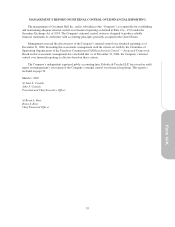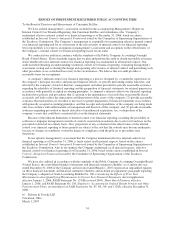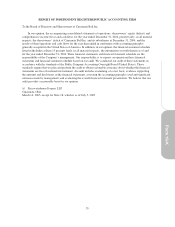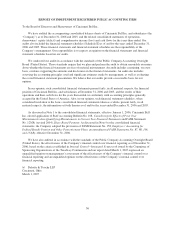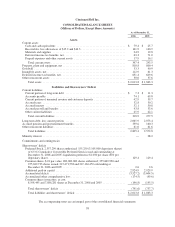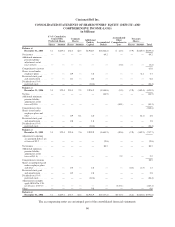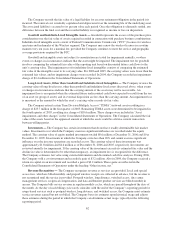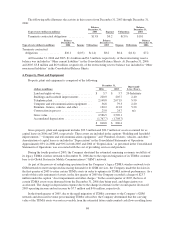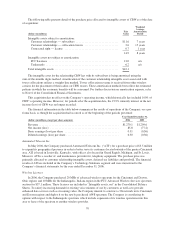Cincinnati Bell 2006 Annual Report Download - page 172
Download and view the complete annual report
Please find page 172 of the 2006 Cincinnati Bell annual report below. You can navigate through the pages in the report by either clicking on the pages listed below, or by using the keyword search tool below to find specific information within the annual report.The Company records the fair value of a legal liability for an asset retirement obligation in the period it is
incurred. The removal cost is initially capitalized and depreciated over the remaining life of the underlying asset.
The associated liability is accreted to its present value each period. Once the obligation is ultimately settled, any
difference between the final cost and the recorded liability is recognized as income or loss on disposition.
Goodwill and Indefinite-Lived Intangible Assets — Goodwill represents the excess of the purchase price
consideration over the fair value of assets acquired recorded in connection with purchase business combinations.
Indefinite-lived intangible assets consist of Federal Communications Commission (“FCC”) licenses for wireless
spectrum and trademarks of the Wireless segment. The Company may renew the wireless licenses in a routine
manner every ten years for a nominal fee, provided the Company continues to meet the service and geographic
coverage provisions required by the FCC.
Goodwill and intangible assets not subject to amortization are tested for impairment annually, or when
events or changes in circumstances indicate that the asset might be impaired. The impairment test for goodwill
involves comparing the estimated fair value of the reporting unit based on discounted future cash flows to the
unit’s carrying value. The impairment test for indefinite-lived intangibles consists of comparing the estimated
fair value of the intangible asset to its carrying value. For 2006 and 2005, the carrying values were lower than the
estimated fair values, and no impairment charges were recorded. In 2004, the Company recorded an impairment
charge of $2.4 million in the Consolidated Statements of Operations.
Long-Lived Assets, Other than Goodwill and Indefinite-Lived Intangibles — The Company reviews the
carrying value of long-lived assets, other than goodwill and indefinite-lived assets discussed above, when events
or changes in circumstances indicate that the carrying amount of the assets may not be recoverable. An
impairment loss is recognized when the estimated future undiscounted cash flows expected to result from the use
of an asset (or group of assets) and its eventual disposition are less than the carrying amount. An impairment loss
is measured as the amount by which the asset’s carrying value exceeds its fair value.
The Company retired certain Time Division Multiple Access (“TDMA”) network assets resulting in a
charge of $23.7 million in the first quarter of 2005. Remaining TDMA assets were determined to be impaired in
the fourth quarter of 2005, resulting in a charge of $18.6 million. These charges were included in “Asset
impairments and other charges” in the Consolidated Statements of Operations. The Company calculated the fair
value of the assets based on the appraised amount at which the assets could be sold in a current transaction
between willing parties.
Investments — The Company has certain investments that do not have readily determinable fair market
values. Investments over which the Company exercises significant influence are recorded under the equity
method. The carrying value of equity method investments totaled $0.6 million at December 31, 2006 and $0 at
December 31, 2005. Investments in which the Company owns less than 20% and cannot exercise significant
influence over the investee operations are recorded at cost. The carrying value of these investments was
approximately $1.8 million and $4.6 million as of December 31, 2006 and 2005, respectively. Investments are
reviewed annually for impairment. If the carrying value of the investment exceeds its estimated fair value and the
decline in value is determined to be other-than-temporary, an impairment loss is recognized for the difference.
The Company estimates fair value using external information and discounted cash flow analyses. During 2006,
the Company sold a cost investment and recorded a gain of $3.2 million. Also in 2004, the Company received a
return on capital on an investment and recorded a gain of $3.2 million. These gains are reflected in the
Consolidated Statements of Operations under the heading “Other income, net.”
Revenue Recognition — The Company recognizes revenue as services are provided. Local and special
access fees, which are billed monthly, and prepaid wireless receipts are collected in advance, but the revenue is
not recognized until the service is provided. Postpaid wireless, long distance, switched access, data center
management services, reciprocal compensation, and data and Internet product services are billed monthly in
arrears. The Company bills service revenue in regular monthly cycles, which are spread throughout the days of
the month. As the day of each billing cycle rarely coincides with the end of the Company’s reporting period for
usage-based services such as postpaid wireless, long distance, and switched access, the Company must estimate
service revenues earned but not yet billed. The Company bases its estimates upon historical usage and adjusts
these estimates during the period in which the Company can determine actual usage, typically in the following
reporting period.
62



